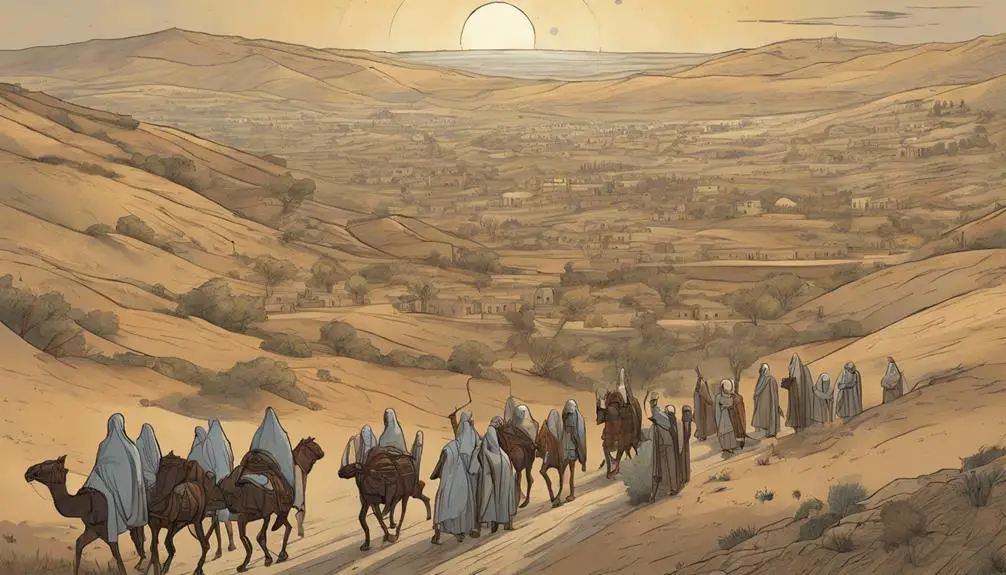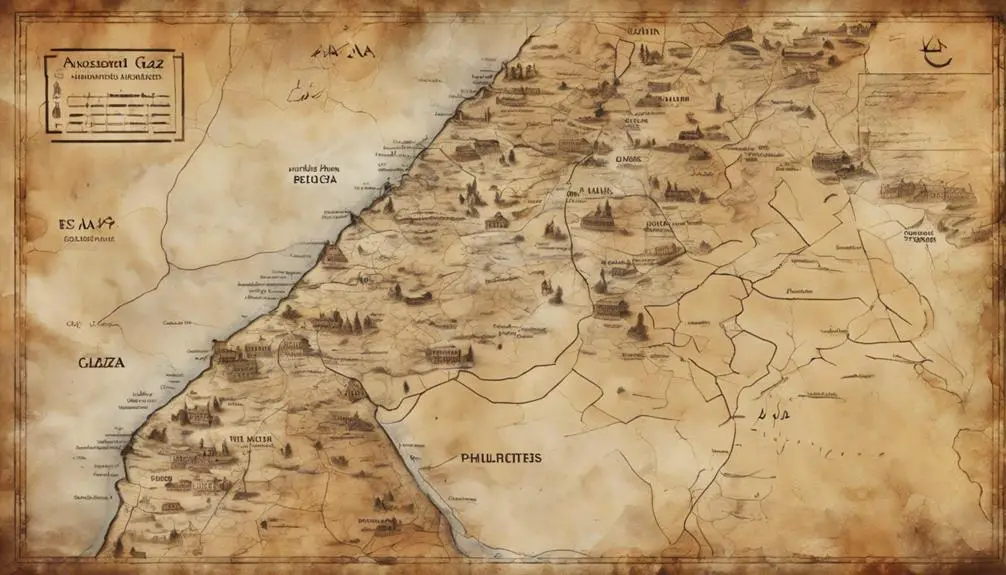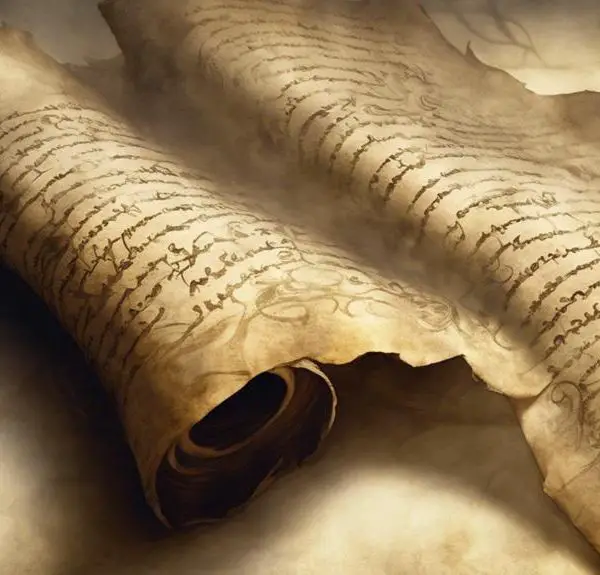Yield to the allure of uncovering Gaza's biblical journey, from Genesis to Acts, and explore its profound impact on scriptural narratives.

Where Is Gaza Mentioned in the Bible
In your journey through the biblical landscape, you might not expect to stumble upon the ancient city of Gaza nestled within the digital pages of scripture.
Yet, it's there, woven through narratives from the patriarchs' travels in Genesis to the mighty feats of Samson in Judges. This coastal city also plays a backdrop to the tumultuous Philistine conflicts in Kings and Chronicles, receives divine warnings through the prophets, and witnesses Philip's evangelism in Acts.
But why does Gaza hold such a recurring role throughout these diverse biblical accounts? Unraveling this could offer insights not only into the text's historical context but also into its enduring relevance.
Key Takeaways
- Gaza is symbolized as a place of divine judgment and call for repentance in biblical accounts.
- The patriarchs' narratives mention arid landscapes, possibly including Gaza, highlighting their spiritual journey and covenant with God.
- Samson's exploits against the Philistines in Gaza underscore themes of divine strength, betrayal, and redemption.
- Philip's evangelism in Acts extends to regions near Gaza, reflecting the spread of the Gospel and inclusivity of faith.
Genesis: The Patriarchs' Journey

In the book of Genesis, the patriarchs' journey through and around Gaza plays a critical role in the unfolding narrative of their lineage and covenant with God. This passage isn't merely a description of desert travels; it's a testament to the challenges and faith of the forebears of Israel. The detailed accounts of their interactions, the altars they build, and the covenants they forge with God in these arid landscapes underscore the significance of family lineage and divine promise.
As you delve deeper, you'll notice that the narrative intricately weaves the physical journey with spiritual development. The patriarchs' traverses across the desert aren't just literal movements but symbolic of their journey towards fulfilling God's promise. This dual narrative highlights the importance of faith, perseverance, and divine guidance in navigating the trials they face.
Moreover, the text subtly points out the strategic importance of Gaza as a crossroads of ancient civilizations. This geographical detail isn't just a historical footnote; it emphasizes the divine plan in situating the patriarchs' journey within a land rich in cultural and historical significance, further enriching the understanding of their family lineage.
Judges: Samson's Feats
Samson's feats, as narrated in the Book of Judges, mark a pivotal moment in the biblical narrative, showcasing his extraordinary strength and complex relationship with the Philistines in Gaza. His encounters in Gaza aren't just tales of brute force but are imbued with symbolic meanings, reflecting the tumultuous relationship between the Israelites and the Philistines.
- Jawbone Weapon: In a display of unparalleled might, Samson uses the jawbone of a donkey to slay a thousand Philistine men. This act isn't merely about physical strength but symbolizes divine intervention and the deliverance of Israel from its oppressors.
- Delilah's Betrayal: The story of Delilah, who betrays Samson to the Philistines, highlights themes of love, deceit, and the fatal consequences of trusting the enemy. It's a pivotal moment that leads to Samson's downfall and eventual capture.
- Blinded and Enslaved: After his capture, Samson's eyes are gouged out, and he's made to grind grain in a Philistine prison, symbolizing the loss of his divine favor and physical power.
- Final Act of Defiance: In his last act, Samson brings down the temple of Dagon, killing himself along with thousands of Philistines, illustrating the idea of ultimate sacrifice for one's people.
These episodes serve not only as historical accounts but also as moral and spiritual lessons on strength, vulnerability, betrayal, and redemption.
Kings and Chronicles: Philistine Conflicts

The Books of Kings and Chronicles provide a detailed account of ongoing conflicts between the Israelites and the Philistines, shedding light on the political and military dynamics that shaped their tumultuous relationship. You'll find that these texts not only narrate the historical skirmishes but also delve into the strategies employed by key figures, notably King David and his son Solomon.
David's victories over the Philistines are pivotal moments that underscore his military prowess and leadership. These triumphs not only secured Israelite territories but also marked a significant shift in power dynamics, weakening the Philistine stronghold in the region. David's approach was both aggressive and strategic, often preempting Philistine moves and decisively defeating them in battle.
On the other hand, Solomon's reign is characterized by a shift towards diplomacy and alliances. Unlike his father, Solomon opted for peace through marriage alliances and trade agreements, stabilizing relations with neighboring states, including Philistine cities. This period of relative peace allowed for the flourishing of Israel under Solomon's rule, highlighting a different but equally effective approach to dealing with Philistine threats.
Together, these narratives offer a nuanced understanding of the complex interplay between war and diplomacy in ancient Near Eastern politics.
The Prophets: Divine Warnings
Throughout the narratives of the Prophets, divine warnings emerge as pivotal themes, cautioning the Israelites against straying from their covenantal obligations and foretelling the consequences of their actions. These narratives, rich with prophetic visions, often underscore the theme of divine retribution for disobedience, particularly in the context of Gaza.
To paint a picture for you:
- Prophetic texts frequently highlight Gaza's fate as emblematic of broader divine judgments, suggesting a direct correlation between moral failings and their repercussions.
- The prophets' warnings to Gaza and its inhabitants serve as a microcosm for the Israelites, urging them to adhere to their divine mandates or face similar consequences.
- Through vivid imagery, these texts depict the desolation and hardship that await those who disregard God's commands, with Gaza often cited as a prime example.
- The emphasis on prophetic visions within these accounts serves not only as a warning but also as a call to repentance, underscoring the possibility of redemption even in the face of impending judgment.
In essence, the Prophets' references to Gaza encapsulate a broader theological discourse on the consequences of disobedience and the relentless hope for repentance and divine mercy.
Acts: Philip's Evangelism

While the Prophets' narratives focus on divine warnings and the call to repentance, Acts introduces a significant shift, showcasing Philip's evangelism in Gaza as an embodiment of the spread of the Gospel and the transformative power of faith. You'll find this pivotal moment where the Gospel reaches an Ethiopian eunuch on a desert road, symbolizing not only geographical but also spiritual journeys. This encounter demonstrates the early Christian mission's inclusivity and the Spirit's guidance in evangelism.
Aspect |
Significance |
|---|---|
Location: Desert Road |
Symbolizes the transition from old to new, from known to the unknown in faith journeys. |
Character: Ethiopian Eunuch |
Represents the expansion of the Gospel beyond Jewish boundaries, emphasizing inclusivity. |
Action: Baptism |
Marks the personal transformation and acceptance of the new faith. |
Guidance: Holy Spirit |
Highlights the divine direction in spreading the Gospel. |
Outcome: Joy |
Reflects the transformative power of faith and acceptance. |
Philip's obedience and the eunuch's openness culminate in a baptism, a profound demonstration of faith's power to unite across cultural and geographic divides. This account underscores the Gospel's universal appeal and the role of divine guidance in evangelistic missions.
Frequently Asked Questions
How Does the Portrayal of Gaza in the Bible Reflect Its Spiritual Significance in Ancient Times?
In analyzing how the Bible reflects Gaza's spiritual significance, you'll find its portrayal intertwined with themes of Gaza's prosperity and spiritual symbolism.
This ancient city's depiction goes beyond mere geography; it embodies a rich tapestry of spiritual narratives. Its prosperity is often highlighted, suggesting a divine favor, while its spiritual symbolism is deeply embedded in biblical stories, offering insights into its revered status in ancient times.
This analysis reveals Gaza's multifaceted spiritual heritage.
Are There Any Parables or Teachings of Jesus That Indirectly Reference or Can Be Associated With the City of Gaza?
You won't find direct mentions of Gaza in Jesus' parables or teachings. However, when analyzing the Gospels, it's clear that Jesus' references to neighboring regions and their people indirectly touch upon the broader geographical and cultural context that includes Gaza.
The absence of explicit Gaza parables doesn't diminish its historical or spiritual context but invites a deeper exploration of Jesus' messages and their relevance across different locales and times.
How Have Archaeologists Used Biblical References to Gaza to Uncover Its Historical Layers and Understand Its Ancient Urban Development?
You'll find that archaeologists have leveraged biblical references to Gaza, employing archaeological methods and focusing on urban stratigraphy. This approach has allowed them to peel back layers of history, revealing the city's complex urban development over millennia.
In What Ways Has the Biblical Narrative of Gaza Influenced Its Perception and Significance in Contemporary Religious Practices?
You'll find that the biblical narrative of Gaza has deeply influenced its modern perceptions and significance in contemporary religious practices.
This influence isn't just theoretical; it's tangible in the boost of religious tourism to the area.
Pilgrims and scholars alike are drawn to explore the layers of history and spirituality embedded in its soil.
This unique blend of ancient narrative and modern faith practices showcases Gaza's enduring legacy in the religious landscape.
Beyond the Canonical Texts, Are There Apocryphal or Non-Biblical Writings That Shed Light on Gaza's Role and Significance in Early Christian Thought and Theology?
You're exploring how apocryphal narratives and Gnostic perspectives might illuminate Gaza's significance in early Christian thought. These less mainstream texts can offer unique insights, diverging from canonical scriptures.
They provide a broader understanding of how early Christians might've perceived Gaza, potentially highlighting its spiritual and theological roles. Analyzing these writings could reveal nuanced interpretations and underscore Gaza's place in a more diverse religious landscape.
Conclusion
In your exploration of Gaza's biblical presence, you've journeyed from the patriarchs' footsteps in Genesis, through Samson's Herculean feats in Judges. You've navigated the tumultuous Philistine conflicts in Kings and Chronicles, heeded divine warnings in the Prophets, and witnessed Philip's evangelical endeavors in Acts.
Gaza, a tapestry of faith, defiance, and prophecy, serves not merely as a geographical footnote but as a cornerstone in the biblical narrative, weaving a complex story of human struggle and divine intervention.



Sign up